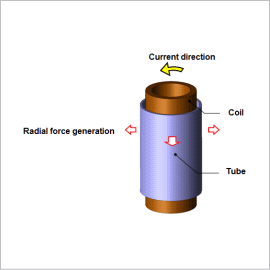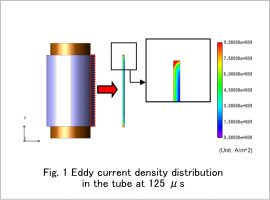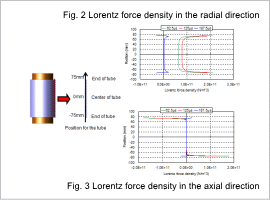*Please prepare a license ID and password for the license administrator.
*It is different from the service for JMAG WEB MEMBER (free membership). Please be careful.
Overview

Electromagnetic forming is a process in which eddy currents are generated in a tube when a large, instantaneous current is run through a coil, creating a strong magnetic field. The tube is formed by using the Lorentz force produced by the interaction between these magnetic fields. This method is different from forming that uses plastic deformation with a press mold because it deforms with the power of the tube itself. This makes it possible to perform difficult forming, like with an object that will not fit into a normal press mold. However, the force generated in the tube is determined from induced eddy currents, which means that it is dynamic deformation, so the behavior of its deformation is known for being difficult to analyze.
Using JMAG to properly analyze the Lorentz force distribution generated in the tube can assist with predicting the deformation behavior of the electromagnetic forming process.
This Application Note explains how to obtain the Lorentz force density distribution generated in a tube when current is run through a coil.
Using JMAG to properly analyze the Lorentz force distribution generated in the tube can assist with predicting the deformation behavior of the electromagnetic forming process.
This Application Note explains how to obtain the Lorentz force density distribution generated in a tube when current is run through a coil.
Eddy Current Density Distribution

The eddy current density distribution generated in the tube at 125 μs is shown in fig. 1. Running high current through the coil creates a strong magnetic field around it, inducing eddy currents in the tube. More eddy currents are generated in the ends of the tube, as shown in fig. 1. This is because the magnetic flux concentrates near the ends of the tube.
Lorentz Force Density Waveform

The Lorentz force densities in the radial direction and the axial direction at each time are shown in figures 2 and 3. The tube expands with the positive values of Lorentz force density in the radial direction, and the tube shrinks with negative values of Lorentz force density in the tube.
The Lorentz force that occurs in the radial direction at 65 μs and 125 μs is produced consistently around the center of the tube, and it becomes drastically larger at the ends, as indicated in fig. 2. This is because the eddy currents concentrate in the ends of the tube. When the current has declined to 187.5 μs, the Lorentz force that occurs shrinks the ends of the tube.
The Lorentz force density in the axial direction only occurs within a 10 mm range at each end of the tube, and it is distributed symmetrically across the center position of 0.
The Lorentz force generated works to shrink the tube as well as to expand it while current is flowing in the coil, so the Lorentz force density in the tube needs to be evaluated using a simulation at the design stage.
The Lorentz force that occurs in the radial direction at 65 μs and 125 μs is produced consistently around the center of the tube, and it becomes drastically larger at the ends, as indicated in fig. 2. This is because the eddy currents concentrate in the ends of the tube. When the current has declined to 187.5 μs, the Lorentz force that occurs shrinks the ends of the tube.
The Lorentz force density in the axial direction only occurs within a 10 mm range at each end of the tube, and it is distributed symmetrically across the center position of 0.
The Lorentz force generated works to shrink the tube as well as to expand it while current is flowing in the coil, so the Lorentz force density in the tube needs to be evaluated using a simulation at the design stage.


